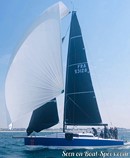JPK 1030
Sailboat specifications
The JPK 1030 is a 33’11” (10.34m) racer-cruiser sailboat designed by Jacques Valer (France). She is built since 2019 by JPK (France).
Find out more about the JPK 1030 on Boat-Spec's blog: European Yacht of the Year 2020 nominated sailboats.
Find out more about the JPK 1030 on Boat-Spec's blog: European Yacht of the Year 2020 nominated sailboats.
JPK 1030's main features
- Model
- JPK 1030
- Hull type
- Monohull
- Category
- Racer-cruiser sailboat
- Sailboat builder
- Sailboat designer
- Country
- France
- Construction
- GRP (glass reinforced polyester):
- Hull: Sandwich Airex fiberglass polyester (vacuum infusion)
- Deck: Sandwich Airex fiberglass polyester (vacuum infusion) - First built hull
- 2019
- Last built hull
- Still in production
- Appendages
- Keel : fin without bulb
- Helm
- Single tiller
- Rudder
- Twin spade rudders
- Unsinkable
- No
- Trailerable
- No
- EC design categoryiThe CE design category indicates the ability to cope with certain weather conditions (the sailboat is designed for these conditions)
A: Wind < force 9, Waves < 10m
B: Wind < force 8, Waves < 8m
C: Wind < force 6, Waves < 4m
D: Wind < force 4, Waves < 0,5m - A
- Standard public price ex. VAT (indicative only)
- About113 000 €(2020)
JPK 1030's main dimensions
- Hull length
- 33’ 11”10.34 m
- Waterline length
- 29’ 8”9.06 m
- Beam (width)
- 10’ 7”3.24 m
- Draft
- 6’ 6”1.98 m
- Light displacement (MLC)
- 7937 lb3600 kg
- Ballast weight
- 3307 lb1500 kg
- Ballast type
- Cast iron / lead fin
JPK 1030's rig and sails
- Upwind sail area
- 657 ft²61 m²
- Downwind sail area
- 1507 ft²140 m²
- Mainsail area
- 377 ft²35 m²
- Genoa area
- 280 ft²26 m²
- Symmetric spinnaker area
- 1023 ft²95 m²
- Asymmetric spinnaker area
- 1130 ft²105 m²
- Rigging type
- Sloop Marconi 9/10
- Mast configuration
- Deck stepped mast
- Rotating spars
- No
- Number of levels of spreaders
- 2
- Spreaders angle
- Swept-back
- Spars construction
- Aluminum spars (carbon fiber spars as an option)
- Standing rigging
- 1x19 strand wire discontinuous
JPK 1030's performances
- Upwind sail area to displacementiThe ratio sail area to displacement is obtained by dividing the sail area by the boat's displaced volume to the power two-thirds.
The ratio sail area to displacement can be used to compare the relative sail plan of different sailboats no matter what their size.
Upwind: under 18 the ratio indicates a cruise oriented sailboat with limited performances especially in light wind, while over 25 it indicates a fast sailboat. - 280 ft²/T25.97 m²/T
- Downwind sail area to displacementiThe ratio sail area to displacement is obtained by dividing the sail area by the boat's displaced volume to the power two-thirds.
The ratio sail area to displacement can be used to compare the relative sail plan of different sailboats no matter what their size. - 642 ft²/T59.6 m²/T
- Displacement-length ratio (DLR)iThe Displacement Length Ratio (DLR) is a figure that points out the boat's weight compared to its waterline length. The DLR is obtained by dividing the boat's displacement in tons by the cube of one one-hundredth of the waterline length (in feet).
The DLR can be used to compare the relative mass of different sailboats no matter what their length:
a DLR less than 180 is indicative of a really light sailboat (race boat made for planning), while a DLR greater than 300 is indicative of a heavy cruising sailboat. - 137
- Ballast ratioiThe Ballast ratio is an indicator of stability; it is obtained by dividing the boat's displacement by the mass of the ballast. Since the stability depends also of the hull shapes and the position of the center of gravity, only the boats with similar ballast arrangements and hull shapes should be compared.
The higher the ballast ratio is, the greater is the stability. - 42 %
- Critical hull speediAs a ship moves in the water, it creates standing waves that oppose its movement. This effect increases dramatically the resistance when the boat reaches a speed-length ratio (speed-length ratio is the ratio between the speed in knots and the square root of the waterline length in feet) of about 1.2 (corresponding to a Froude Number of 0.35) . This very sharp rise in resistance, between speed-length ratio of 1.2 to 1.5, is insurmountable for heavy sailboats and so becomes an apparent barrier. This leads to the concept of "hull speed".
The hull speed is obtained by multiplying the square root of the waterline length (in feet) by 1.34. - 7.31 knots
JPK 1030's auxiliary engine
- Engine(s)
- 1 inboard engine
- Engine(s) power
- 18 HP
- Fuel type
- Diesel
- Fuel tank capacity
- 9.2 gal35 liters
JPK 1030's accommodations and layout
- Cockpit
- Open aft cockpit
- Cabin(s)
- 2
- Berth(s) (min./max.)
- 4 / 6
- Head(s)
- 1
- Freshwater tank capacity
- 21.1 gal80 liters
- Maximum headroom
- 6’ 1”1.86 m
JPK 1030's fore cabin
- Berth length
- 6’ 7”2 m
- Berth width
- 4’ 11”1.5 m
JPK 1030's aft cabin
- Berth length
- 6’ 5”1.95 m
- Berth width
- 4’ 11”1.5 m









JPK 1030 interior and accommodations - - 8/8
Picture extracted from the commercial documentation © JPK
Picture extracted from the commercial documentation © JPK
Similar sailboats that may interest you:
Sailboats
First built hull
Hull length
2006
35’ 10”10.9 m
2017
32’9.75 m
2017
40’12.2 m
1985
32’ 7”9.95 m
2019
32’ 7”9.94 m
2007
32’ 1”9.78 m
2018
38’ 7”11.78 m
2012
32’ 10”9.99 m
2010
32’ 10”10 m
1984
35’ 8”10.87 m
2006
34’ 8”10.59 m
2014
34’ 8”10.59 m
2014
35’ 5”10.8 m
2012
36’ 5”11.1 m
2003
39’ 2”11.95 m